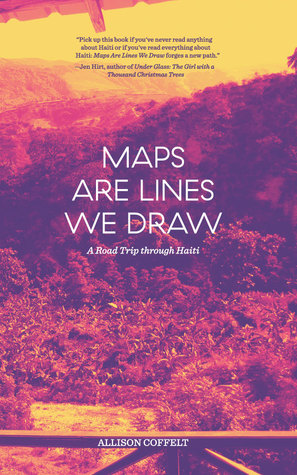Reviewed by Vicki Mayk
 The words “travel writing” instantly conjure thoughts of magazine features extolling the sights, sounds, cuisine, and culture of a foreign land. But some of the best writing about travel is found in travel memoirs and focuses on the personal transformation that occurs as a result of experiencing a new place and different culture. That kind of personal transformation is the motivation of Allison Coffelt’s Maps Are Lines We Draw: A Road Trip through Haiti (Lanternfish Press, March 2018).
The words “travel writing” instantly conjure thoughts of magazine features extolling the sights, sounds, cuisine, and culture of a foreign land. But some of the best writing about travel is found in travel memoirs and focuses on the personal transformation that occurs as a result of experiencing a new place and different culture. That kind of personal transformation is the motivation of Allison Coffelt’s Maps Are Lines We Draw: A Road Trip through Haiti (Lanternfish Press, March 2018).
Coffelt’s slim, 137-page volume tells the story of her trip to Haiti – a journey ten years in the making. She traces her fascination with the country to the time in high school when she read Tracy Kidder’s Mountains Beyond Mountains. Kidder’s book, she recounts, sparked not only a fascination with the island nation, but also an interest in global public health, because it centered on the work of the organization Partners In Health working to bring health care to the poor in Haiti. Coffelt explains that reading the book “came at a time when I was open to being changed, and so it altered my trajectory.”
That early experience is what eventually leads Coffelt to visit the Caribbean nation, traveling with Dr. Jean Gardy Marius, founder of the public health organization OSAPO. Using a braided narrative, Coffelt skillfully writes about several themes, alternating between them to present a memoir that is both deeply personal and thought provoking. The multiple threads in Coffelt’s narrative include her early fascination with maps, globes and travel, the stories of experiences on her road trip in Haiti, facts about Haiti’s troubled history, information about its flora and fauna, and notes about the successes and failures of various humanitarian missions to the country. In the hands of a less skillful writer, so many themes could make for chaotic storytelling. Instead, Coffelt gives us a beautifully written book that explores both personal experience and global issues.
As she weaves back and forth in her story, we are left with a startling picture of Haiti, a chronicle of Coffelt’s experiences there and with new insights about what happens when humanitarian efforts succeed and what happens with they go wrong. A section in which Coffelt writes about selling clothing and textiles in Haiti illustrates how she is able to accomplish all three of these things without ever losing her reader. First, Coffelt recounts something that she observes while traveling with Dr. Gardy:
“We pass a small town and through the window I see a man whose shirt implores SAVE SENIOR WEEK. A few days ago, I walked by someone wearing the grey, red-letter D.A.R.E. from my middle school’s “Just Say No to Drugs” program.
“I have seen stock footage of women in vivid oranges and reds, perhaps with head wraps of majestic purple, carrying pitchers of water on their crowns. But this is not how Haiti is.
“Haiti is a graveyard for clothes.”
From such a succinct and telling anecdote, Coffelt proceeds to explain how 9 billion pounds of used textiles are exported in a 17-year period from the United States to countries like Haiti. From such a fact, she returns to a description of a market in Haiti with its native vendors selling myriad wares, from prom dresses to soccer balls. We are introduced to a vendor named Nancie, who sells the textiles exported to Haiti – like the familiar t-shirts that Coffelt has glimpsed. Before she is done, Coffelt skillfully brings the reader full circle, writing about what it means to flood markets with wares like the clothing – and how it damages, rather than helps, Haiti’s economy.
Such blending of personal experiences with larger, more global issues continues throughout Coffelt’s book, leaving us with a story that is sometimes troubling, often moving, and always well-written. We are there with her, from holding her headlamp so a doctor can minister to a seriously ill man in a clinic to traveling the roads with Dr. Gardy. We are there as she recounts the troubled history of the island. We are there as she meets a rich cast of real people in her travels. And when Coffelt is done, she has accomplished what Tracy Kidder’s book did for her so many years ago: She has written a book that will challenge the way readers think about another country and about the way well-intentioned outsiders offer it aid.
 Vicki Mayk is a memoirist, nonfiction writer and magazine editor whose work has appeared in print and online publications including Ms Magazine, Hippocampus Magazine, Literary Mama, and the Manifest-Station. She created and teaches a memoir workshop for the bereaved at St. Luke’s Hospice in Bethlehem, Pa., and teaches writing workshops for those dealing with loss under the umbrella of her consulting business, Write To Heal.
Vicki Mayk is a memoirist, nonfiction writer and magazine editor whose work has appeared in print and online publications including Ms Magazine, Hippocampus Magazine, Literary Mama, and the Manifest-Station. She created and teaches a memoir workshop for the bereaved at St. Luke’s Hospice in Bethlehem, Pa., and teaches writing workshops for those dealing with loss under the umbrella of her consulting business, Write To Heal.
Vicki is the editor of the magazine at Wilkes University, where she also teaches adult creative nonfiction workshops and a class about the power of story for freshmen.


